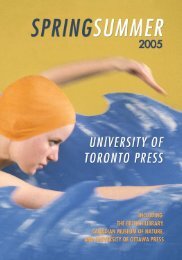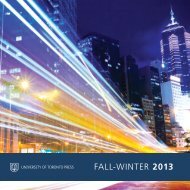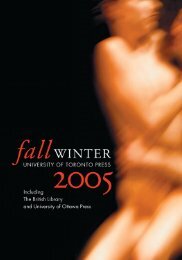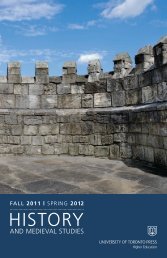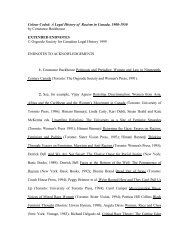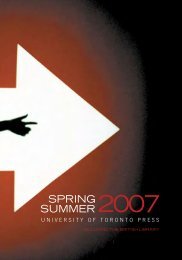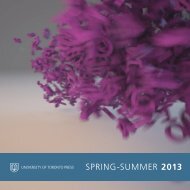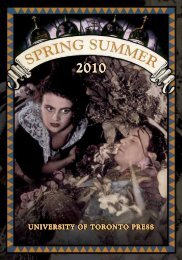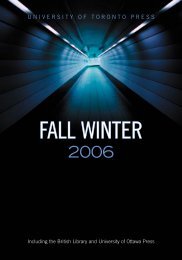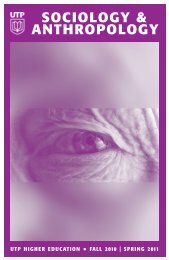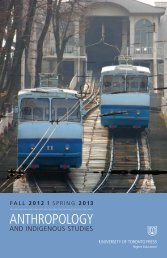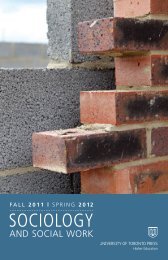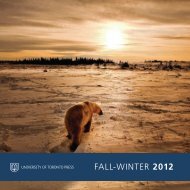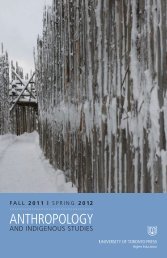Classics, Medieval & Renaissance 2012 - University of Toronto ...
Classics, Medieval & Renaissance 2012 - University of Toronto ...
Classics, Medieval & Renaissance 2012 - University of Toronto ...
Create successful ePaper yourself
Turn your PDF publications into a flip-book with our unique Google optimized e-Paper software.
Tudor Historical Thought<br />
RENAISSANCE SOCIETY OF AMERICA REPRINT TEXTS<br />
F.J. Levy<br />
Tudor Historical Thought is a revealing account <strong>of</strong> vital changes in intellectual orientation. F.J. Levy’s seminal<br />
work explores the factors – humanism, theology, antiquarianism, Machiavellianism – that brought about<br />
the changes in historical thinking from the time <strong>of</strong> Caxton to that <strong>of</strong> Bacon, Raleigh, and Camden.<br />
At the beginning <strong>of</strong> the sixteenth century, chroniclers exemplified the workings <strong>of</strong> Providence and taught<br />
personal morality; a hundred years later, however, the idea <strong>of</strong> teaching practical statecraft had been introduced.<br />
The Italian humanists emphasized the political aspects <strong>of</strong> man, and made the active citizen rather<br />
than the cloistered monk their ideal. That citizen needed guidance, and it was the duty <strong>of</strong> the historian to<br />
supply it. Questions <strong>of</strong> politics, which had been important for nearly half a century, suddenly were placed<br />
at the centre, and with that a new kind <strong>of</strong> history writing appeared in England.<br />
(RSART 15) 320 pp / 6 x 9 / 2004<br />
Paper 978-0-8020-3775-6 $32.95 (£23.99)<br />
The <strong>Renaissance</strong> in Historical Thought<br />
Wallace K. Ferguson<br />
Originally published in 1948, Wallace K. Ferguson’s The <strong>Renaissance</strong> in Historical Thought is a key piece<br />
<strong>of</strong> scholarship on <strong>Renaissance</strong> historiography. Ferguson examines how the <strong>Renaissance</strong> has been viewed<br />
from successive historical and national viewpoints, and by canonical thinkers over the centuries, including<br />
François-Marie Arouet de Voltaire and Jacob Burckhardt.<br />
(RSART 16) 450 pp / 6 x 9 / 2006<br />
Paper ISBN 978-0-8020-9415-5 $32.95 (£23.99)<br />
The Social World <strong>of</strong> the Florentine Humanists, 1390–1460<br />
Lauro Martines<br />
Lauro Martines’s exhaustive search <strong>of</strong> manuscript material in the state archives <strong>of</strong> Florence is the basis for a<br />
fascinating portrayal <strong>of</strong> representative humanists <strong>of</strong> the period. The Social World <strong>of</strong> the Florentine Humanists<br />
explores the wealth, family tradition, civic prominence, and intellectual achievements <strong>of</strong> these individuals<br />
while assessing the attitudes <strong>of</strong> other Florentines towards them. Martines demonstrates that humanists<br />
tended to be wealthy educated men from important families, challenging longheld assumptions about the<br />
status <strong>of</strong> humanists in that society.<br />
First published in 1963, this groundbreaking study provides a detailed picture <strong>of</strong> the social structure<br />
<strong>of</strong> Florence in the Quattrocento that influenced a generation <strong>of</strong> scholars and illuminated a complex and<br />
multifaceted world.<br />
(RSART 17) 440 pp / 6 x 9 / 2011<br />
Paper ISBN 978-1-4426-1182-5 $35.00 (£24.99)<br />
The World <strong>of</strong> the Florentine <strong>Renaissance</strong> Artist<br />
Projects and Patrons, Workshop and Art Market<br />
Martin Wackernagel<br />
Translated by Alison Luchs<br />
First published in German in 1938 and later translated into English, this classic <strong>of</strong> Italian <strong>Renaissance</strong> historiography<br />
centres on the relationship between Florentine art and the conditions under which it was created. In<br />
rich detail, Martin Wackernagel explores the impact <strong>of</strong> patronage and function, widespread demand for<br />
art, workshop techniques, and business practices on artists’ lives and the results they achieved.<br />
Wackernagel stresses the changing roles <strong>of</strong> commissions and patrons in the late fourteenth to the early<br />
fifteenth centuries, from small-scale enterprise under Lorenzo de Medici to the large-scale development <strong>of</strong><br />
major Florentine monuments. Through this, he highlights the development <strong>of</strong> major civic and religious<br />
artistic complexes such as the Palazzo Vecchio, the Cathedral and Baptistery, and the convent <strong>of</strong> Santa<br />
Maria Novella. This volume also features a biography <strong>of</strong> the author and an essay on important later publications<br />
related to Wackernagel’s themes and arguments.<br />
(RSART 18) 488 pp / 6 x 9 / 2011<br />
Paper ISBN 978-1-4426-1184-9 $39.95 (£27.99)<br />
utppublishing.com 49



